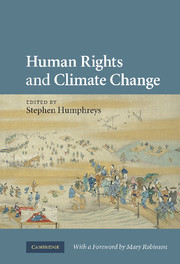Book contents
- Frontmatter
- Contents
- Authors' biographies
- Acronyms
- Acknowledgements
- Foreword
- Introduction: human rights and climate change
- PART I Rights perspectives on global warming
- PART II Priorities, risks and inequities in global responses
- 6 The Kyoto Protocol and vulnerability: human rights and equity dimensions
- 7 Forests, climate change and human rights: managing risks and trade-offs
- 8 Climate change and the right to the highest attainable standard of health
- 9 Human rights and vulnerability to climate change
- 10 Climate change, evolution of disasters and inequality
- Conclusion
- Appendix: climate change impacts on human rights
- Index
- References
7 - Forests, climate change and human rights: managing risks and trade-offs
from PART II - Priorities, risks and inequities in global responses
Published online by Cambridge University Press: 04 August 2010
- Frontmatter
- Contents
- Authors' biographies
- Acronyms
- Acknowledgements
- Foreword
- Introduction: human rights and climate change
- PART I Rights perspectives on global warming
- PART II Priorities, risks and inequities in global responses
- 6 The Kyoto Protocol and vulnerability: human rights and equity dimensions
- 7 Forests, climate change and human rights: managing risks and trade-offs
- 8 Climate change and the right to the highest attainable standard of health
- 9 Human rights and vulnerability to climate change
- 10 Climate change, evolution of disasters and inequality
- Conclusion
- Appendix: climate change impacts on human rights
- Index
- References
Summary
In the mid-1980s, tropical deforestation splashed onto the international agenda as the world became aware of threats to the survival of the human and biological diversity sustained by tropical forests. Activists protested the road-building and transmigration projects that were catalysing deforestation in Brazil and Indonesia; bilateral and multilateral donors mobilized funds for investment in forest protection; conservation organizations established alliances with indigenous and traditional peoples; and governments launched negotiations toward an international agreement on forests. Interest in tropical forests peaked in the aftermath of the United Nations Conference on Environment and Development (UNCED) in Rio in 1992, and steadily declined over the next decade as national and international efforts to reverse deforestation proved disappointing.
Tropical deforestation has now reappeared on the international agenda due to its newly-appreciated link to climate change. In 2006, a review commissioned by the Government of the United Kingdom (Stern 2007) called attention to the fact that some 20 per cent of current annual global greenhouse gas (GHG) emissions is due to land use change – most of which is deforestation in developing countries – a share greater than the emissions produced by the transport sector globally. The review asserted that controlling deforestation could provide one of the least expensive strategies for reducing emissions, and that such efforts must be a key element of any future climate protection regime. As a result, reducing emissions from deforestation and degradation (REDD) is now central to discussions of global and national mitigation strategies.
- Type
- Chapter
- Information
- Human Rights and Climate Change , pp. 207 - 237Publisher: Cambridge University PressPrint publication year: 2009
References
- 9
- Cited by



